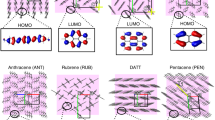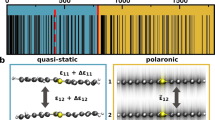Abstract
PROBLEMS involving the simultaneous transport of electrons and holes by drift and diffusion arise in connection with a great variety of solid-state phenomena and devices. Their analysis is handicapped because transport equations defy explicit solution for the general case. The choice must be made between computer-derived numerical solutions of the complete equations for particular parameters and boundary conditions, or explicit treatment of the equations with sufficient ad hoc assumptions (for example, bulk neutrality, zero recombination, freedom from traps) to permit their solution. The former is cumbersome and excessively specific for many purposes; the latter is often misleading, because the precise consequences of ad hoc assumptions cannot be easily foreseen. It is hoped that they affect only the accuracy of the results, but there are many instances when ‘simplifying’ assumptions distort the entire physical picture. We report here a third possibility, namely explicit solutions of the equations in linearised form, but without any other simplifying assumptions. The significance of these results is limited to low currents (‘small signal theory’) but the conclusions are otherwise general, and permit the convenient examination of the various processes as a function of the transport parameters. Moreover, the same set of equations can be applied to various problems by suitable adjustment of the boundary conditions. Such procedures have been used with two distinct problems: (1) the injection of minority carriers into lifetime and relaxation semiconductors, with and without traps1,2, and (2) the Hall effect3 in specimens of finite size. The analysis even in linearised form is complex, and the details are published elsewhere, but explicit solutions can be obtained. They lead to new conclusions on the nature of the process involved.
This is a preview of subscription content, access via your institution
Access options
Subscribe to this journal
Receive 51 print issues and online access
$199.00 per year
only $3.90 per issue
Buy this article
- Purchase on Springer Link
- Instant access to full article PDF
Prices may be subject to local taxes which are calculated during checkout
Similar content being viewed by others
References
Manifacier, J.-C. & Henisch, H. K. Phys. Rev. (in the press).
Manifacier, J.-C. & Henisch, H. K. Phys. Rev. (in the press).
Manifacier, J.-C. Phys. Rev. (in the press).
Shockley, W. Electrons and Holes in Semiconductors (Van Nostrand Company, Inc., New York, 1950).
Van Roosbroeck, W. & Casey, H. C. Jr Phys. Rev. B56, 2154 (1972).
Kiess, H. & Rose, A. Phys. Rev. Lett. 30, 153 (1973)
Popescu, C. & Henisch, H. K. Phys. Rev. B11, 1563 (1975).
Popescu, C. & Henisch, H. K. Phys. Rev. B14, 517 (1976).
Fowler, R. H. Statistical Mechanics (Cambridge University Press, 1936).
Banbury, P. C., Henisch, H. K. & Many, A. Proc. Phys. Soc. 66, 753 (1953).
Landauer, R. & Swanson, J. Phys. Rev. 91, 555 (1953).
Tauc, J. Amorphous and Liquid Semiconductors (Plenum, New York, 1974).
Author information
Authors and Affiliations
Rights and permissions
About this article
Cite this article
MANIFACIER, JC., HENISCH, H. New results from linearised charge transport theory. Nature 272, 521–522 (1978). https://doi.org/10.1038/272521a0
Received:
Accepted:
Issue Date:
DOI: https://doi.org/10.1038/272521a0
Comments
By submitting a comment you agree to abide by our Terms and Community Guidelines. If you find something abusive or that does not comply with our terms or guidelines please flag it as inappropriate.



